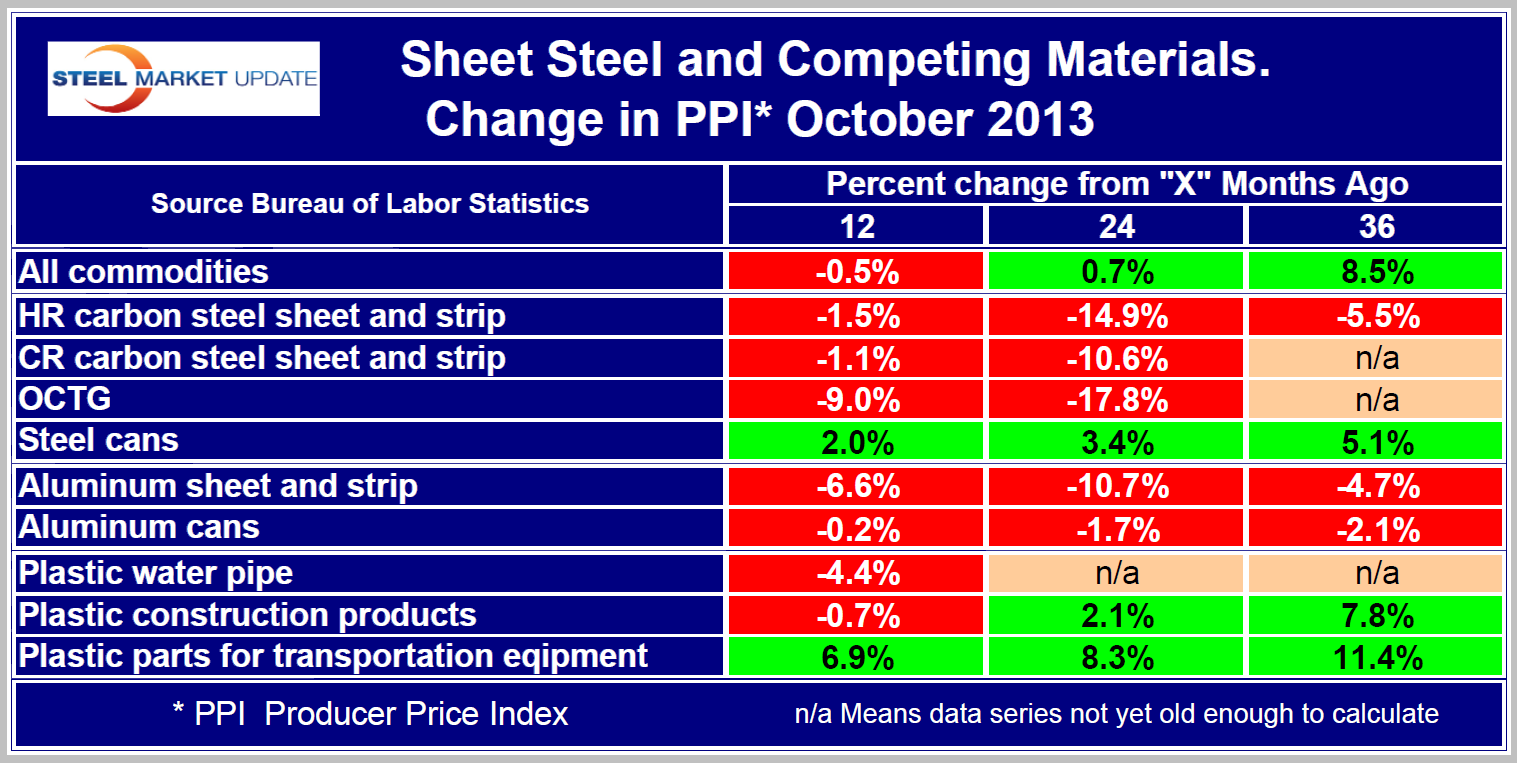Economy

Producer Price Indexes of Sheet Steel and Competing Materials
Written by John Packard
November 21, 2013
Each month the Bureau of Labor Statistics puts out its series of producer price indexes, for thousands of goods and materials. The latest release on Thursday reported October results. These statistics are a useful way to evaluate any changes in the competitive position of steel against competing materials.
For the purpose of this report, SMU extracts comparative statistics for sheet steel, aluminum and plastic products. The headline on Thursday was that the composite PPI fell 0.2 percent in October, declining for the second straight month. A sharp drop in energy prices undermined gains in food and core finished goods producer prices.
Moody’s reported as follows in Economy.com: “Producer prices were broadly weak last month at all stages of production and across most commodity groups. Between them, lower energy and food commodity prices are easing costs for firms in virtually all finished product categories. With input prices rising at about their slowest pace since the recession, consumer prices will at best hold their weak trend through the end of the year. A firmer recovery in Europe, stronger growth in developing countries, and more certainty about U.S. fiscal and monetary policy will drive commodity prices higher next year.
The recovery in Europe is uneven, and developing countries appear to still have plenty of excess capacity, causing pricing power on U.S.-bound shipments to slip. Moreover, metals traders have been especially subdued while they await key policy decisions by Chinese authorities that may significantly alter the country’s reliance on investment-fueled economic growth. Less Chinese spending on infrastructure will lower demand for industrial metals in the medium term.
Crude oil prices have fallen steadily over the past month as temporary supply disruptions in some countries have failed to dent overall global supply. Any further buildup in U.S. oil inventories due to rising production or imports will threaten to rout prices. Improved transportation of domestically produced crude oil to refining centers in the Gulf and the Northeast has pushed gasoline prices to almost 10% below year-ago levels, the steepest pace of decline since the recession. A modest rebound is in the cards, but prices could surprise on the downside. Refineries continue to operate above 85% of capacity despite the end of the driving season, suggesting adequate profitability at current prices.”
Table 1 is a summary of steel, aluminum and plastic indexes. Four cells in this table contain the code n/a. In the last two years the BLS has expanded its range of products within the PPI series with the result that long term comparisons cannot yet be made in these four cases.
What the PPI data shows is that commodities in general, with a 0.5 percent decline in the three month moving average, were down by more than the total PPI index for October. Most steel, plastic and aluminum products were down by even more. What is important for our industry is the relative change in cold rolled steel and aluminum sheet. In order to meet government mandated fleet economy ratings the automobile manufacturers are taking the vehicle weight issue very seriously. Ultra high strength steels are competing head to head with aluminum and winning some as they lose others. The 2014 Ford 150 pickup, for example, has been reported to be highly aluminum intensive. In the last 12 months, the PPI of cold rolled sheet has declined by 1.1 percent but aluminum sheet is down by 6.6 percent, presumably because aluminum, which has a much higher energy cost of manufacture, is benefiting from lower energy prices. The future energy economy of the US could work against the competitive position of steel.
The price of steel food and beverage containers is steadily becoming less competitive against aluminum, a situation that has worsened drastically since the end of 2008.
The PPI data are helpful in monitoring the competitive price of steel and steel products against competing materials and products. As far as we can tell from comparison with known transaction prices, these PPI are a good representation of the real world.

John Packard
Read more from John PackardLatest in Economy

Multi-family pullback drives housing starts to 5-year low in May
US housing starts tumbled in May to a five-year low, according to figures recently released by the US Census Bureau.

Architecture firms still struggling, ABI data shows
Architecture firms reported a modest improvement in billings through May, yet business conditions remained soft, according to the latest Architecture Billings Index (ABI) release from the American Institute of Architects (AIA) and Deltek.

Manufacturing in New York state contracts again
However, companies are growing more optimistic about the future.

ArcelorMittal plans wire-drawing closure in Hamilton, shifts production to Montreal
ArcelorMittal’s (AM) Hamilton location to be shuttered, wire production shifting to Montreal.
Beige Book finds growing economic, policy uncertainty
All districts reported "hesitancy and a cautious approach to business and household decisions,” according to the Beige Book.

